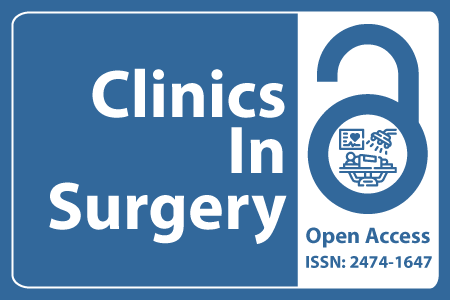
Journal Basic Info
- Impact Factor: 1.995**
- H-Index: 8
- ISSN: 2474-1647
- DOI: 10.25107/2474-1647
Major Scope
- Robotic Surgery
- Minimally Invasive Surgery
- Gastroenterological Surgery
- Urology
- Plastic Surgery
- Bariatric Surgery
- Neurological Surgery
- Otolaryngology - Head and Neck Surgery
Abstract
Citation: Clin Surg. 2017;2(1):1320.Research Article | Open Access
Does Autologous Gastrointestinal Reconstruction Reduce Catheter-Related Blood Stream Infections? Experience of an Intestinal Rehabilitation Unit
Coletta Riccardo, Lansdale Nick and Morabito Antonino
Division of Cell Matrix Biology and Regenerative Medicine, University of Manchester, UK
School of Environment and Life Sciences, University of Salford, UK
Department of Paediatric Surgery, Royal Manchester Children’s Hospital, UK
Department of Paediatric Surgery, Alder Hey Children's NHS Foundation Trust Liverpool, UK
*Correspondance to: Antonino Morabito
PDF Full Text DOI: 10.25107/2474-1647.1320
Abstract
Background and Aims: Catheter-related blood stream infections (CRBSI) occur frequently in Short Bowel Syndrome (SBS) children on parenteral nutrition (PN). Central venous catheter (CVC) complication and complete loss of central venous access are indication for intestinal transplantation. Autologous gastrointestinal reconstruction surgery (AGIR) is mandatory in any chronically PNdependent patient when there is substantial bowel dilation to reduce bacterial translocation. We reviewed patients who underwent lengthening surgery and calculated the rate of CRBSI pre and post surgery.Materials and
Methods: PN dependent children with SBS were identified. Inclusion criteria were CVC for PN administration pre and post-operatively, CVC removed after weaned off PN and having gained enteral autonomy. CRBSI episodes were defined as temperature above 38.0°C, along with positive blood culture microbiological infection from the CVC.Results: Nineteen patients were identified (male n=13). Median gestation was 35 (33.5-36.5) completed weeks and birth weight 2080g (1725-2374). Ten patients underwent tapering enteroplasty, eight Longitudinal Intestinal Lengthening and Tailoring (LILT) procedure, and one Serial Transverse Enteroplasty (STEP) procedure. Median duration of PN was 5.3 months (2.9-6.6) pre and 9.0 months (4.2-10.9) post surgery. A total of 115 septic episodes were confirmed (70 prior to surgery and 45 post surgery). The total rate of catheter related sepsis was significantly lower after AGIR compared to before it (p=0.016).Conclusion: CRBSI frequency in PN dependent patients with dilated bowel reduces after AGIR. AGIR appears associated with significantly reduced frequency of CRBSI in PN dependent children with bowel dilatation. These findings warrant further exploration in larger, preferably controlled studies.
Keywords
Cite the article
Riccardo C, Nick L, Antonino M. Does Autologous Gastrointestinal Reconstruction Reduce Catheter- Related Blood Stream Infections? Experience of an Intestinal Rehabilitation Unit. Clin Surg. 2017; 2: 1320.













